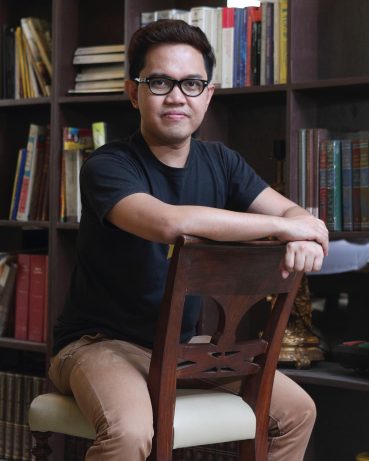Edgar Calabia Samar, born in San Pablo City, Philippines in 1981, is the award-winning author of works including Eight Muses of the Fall, longlisted for the 2009 Man Asian Literary Prize, and the five-book series, Janus Silang (Tuttle Publishing 2023 & 2024). The latter is a young-adult fantasy series that features other worlds, mythology and online gaming.
Edgar has been called “one of Asia’s best-known writers,” and one reviewer has said, “If Britons have Harry Potter and Americans have Percy Jackson, we Filipinos have Janus Silang.” He has also written award-winning short stories, essays and poetry, had his works turned into plays, and served as a writer in residence for the International Writing Program of the University of Iowa.
During high school, he wrote regular columns for newspapers and news magazines, then attended Ateneo de Manila University, where he graduated with an undergraduate degree in Psychology and Master’s degree in Literature. He earned his Ph.D. in Creative Writing from the University of the Philippines Diliman. He is currently an associate professor at Ateneo, where he teaches Philippine Literature and Creative Writing.
He can be found at https://en.wikipedia.org/wiki/Edgar_Calabia_Samar, https://edgarcalabiasamar.com/about/, and https://www.goodreads.com/ecsamar.
Q: How does it feel to be called one of Asia’s best-known writers, the Philippines’ Harry Potter/Percy Jackson? In other words, how does it feel to help put Filipino literature on the world map?
A: Most of my long-time readers know that Janus Silang is neither Harry Potter nor Percy Jackson. So, the people who make this comparison are usually those who just got introduced to the series. Honestly, this is something that I just had to come to terms with, but I still sometimes feel discomfort having my works compared to them because, if at all, my works are a reaction to them. If you are writing in a minority language like Filipino, I cannot imagine your work not being a reaction to works being written in a dominant language like English, especially with our colonial history. But of course, if such comparisons help a marginal work like mine to pique the interest of English readers, by all means.
Q: Tell us about your six fantasy books.
A: My first book was a children’s book, Uuwi na ang Nanay Kong si Darna, which won the Philippine Board on Books for Young People Salanga Writer’s Prize in 2002. There were unauthorized translations of the story to English here and there, some of them published in Philippine textbooks, but the book itself does not have an English/bilingual edition yet. Then there’s the five-book Janus Silang series which is not yet entirely available in English — just the graphic novel adaptations of the first two books that Tuttle Publishing released in 2023 and 2024.
Q: How excited are you that these graphic-novel versions in your extremely popular Janus Silang series are now available in English? And will English readers eventually have the entire five-book series available to them?
A: While I am, of course, super excited and extremely grateful that the books will finally be available to English readers in their graphic novel adaptations by the extremely talented Carljoe Javier, Natasha Ringor and Mervin Malonzo, I still hope for the novels themselves to get translated soon! We don’t have the graphic novel adaptations of the last three books, even in Filipino, so how can you finish the series unless we have the novels themselves translated? However, I heard through the grapevine that the first novel is finally getting an English translation. Let’s wait and see.
Q: The Janus Silang series falls into so many categories: fantasy, horror, adventure, mystery, mythology. What are the biggest challenges and rewards of creating such a complex other world?
A: When I was writing the series, especially the first book, I was not necessarily thinking of these genre categories and where my book would fall into them. I was just trying to follow this mysterious story, being drawn into the life of this specific character and getting myself excited and surprised at how equally impressive and frightening his world is. One of the biggest challenges in writing such a work is making everything believable to the point that the readers would actually care for the characters. The reward is in proving to myself that I can actually pull off such a complex tale in an equally intricate Santinakpan (this is the world of the story) where readers now root for not just one character but many other characters, most of the time to the point of heartbreak.
Q: What kinds of youth do you think are drawn to fantasy and why?
A: I don’t know if a specific kind of youth is drawn to fantasy. I just know that fantasy comes naturally to kids; we grow up believing and fearing things that do not necessarily follow the logic of science. I think the youth who are drawn to fantasy are the ones who are drawn to stories and storytelling in general. These young people believe deep within them that the world we have does not necessarily have to be the only world we have. We need these young ones. We need people who can imagine a different world and who believe that a better world is possible.
Q: Please tell us about any future goals or books in the works, and when you may next be touring North America.
A: Wait, is touring North America a possibility? When do I get an invite? Ha-ha. In all seriousness, I’m just focused now on working on my new novels in Filipino; I have a new one being serialized in the oldest running magazine in the Philippines, Liwayway. I also have a trilogy of novels that just came out late last year. This trilogy (Trilohiya ng mga Bilang, or “Trilogy of Numbers”) is composed of novels that were almost two decades in the making, and all of them have won important literary awards in the Philippines, including the Palanca Awards. Of course, I dream of many of my works getting translated into English and other languages because I write, hoping to be read by as many people as possible. But writing in Filipino, I cannot preoccupy myself with eventual translations that may or may not happen. Writing in Filipino remains, for me, a love letter to everyone important to me, to the history that made this language possible, which made all my relationships possible, which made everything I imagined and wrote possible.
– Pam Withers

